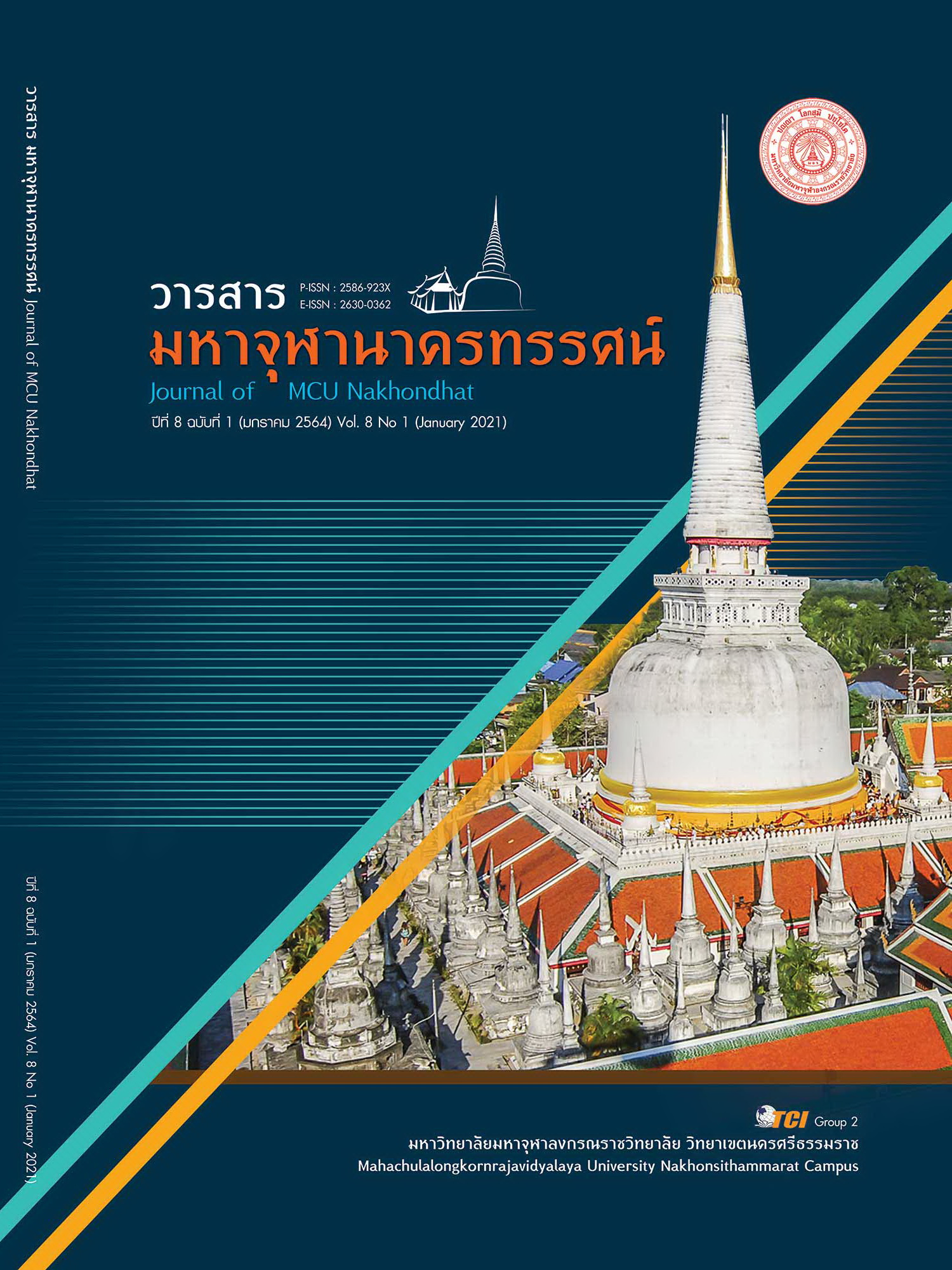THE DEVELOPMENT OF THE OPERATION MODEL OF BUDDHIST ORIENTED SCHOOL
Main Article Content
Abstract
The objectives of this article were: 1) to study the current state. Buddhist way of school operation mode. And 2) to develop a Buddhist method school operating model. By being a research on the development model by Conducting research, including 1) studying the conceptual framework of the research from document analysis, 2) studying conditions and problems using questionnaires Select a specific sample represented by an executive director from 379 persons, 3) studying the model and sketch of the pattern using semi - structured interviews. Select a specific sample represented by the Buddhist method school from 21 persons. To bring to draft the form by the workshop and check the draft by using expert seminar, and 4) to develop a Buddhist method school operating model by focus group. The sample was chosen by purposive sampling from 10 persons using the statistics, percentage, frequency () mean and standard deviation (S.D.). By analyzing the content and summarizing. The research was found that: 1) the current state is the current Buddhist way schools operate at 3 levels such as: 1.1) the general Buddhist way schools, 1.2) the leading Buddhist school, and 1.3) the Buddhist ways of the royal school. There are 6 steps to implement such as: 1) Preparation, 2) Implementation of the condition and composition, 3) Implementation of the Trisikha system, 4) Close supervision, 5) Improvement and further development, and 6) Evaluation and dissemination of performance. And 2) the develop model by bringing the principles to support. There are 6 steps: 2.1) Belief and agency, 2.2) Panya Wuthitham, 2.3) Trisikha, 2.4) Kanlayanamit, 2.5) Ittibah 4 Upanyatham 2, and 2.6) Joy and appreciation together. And operating model at 3 levels such as: 1) a network of Buddhist ways of schools, 2) Building a Buddhist youth leader, and 3) community development based on the Buddhist way of life. To promote the process of operating the Buddhist schools to be more efficient.
Article Details
References
โรงเรียนวิถีพุทธ. (2563). โรงเรียนวิถีพุทธ พุทธธรรมประยุกต์เพื่อการศึกษา. เรียกใช้เมื่อ 5 มกราคม 2563 จาก www.vitheebuddha.com /main.php?url=about&id
กรกมล หนูจันทร์ และคณะ. (2561). การพัฒนารูปแบบการบริหารโรงเรียนวิถีพุทธระดับปฐมวัยของโรงเรียนในสังกัดสำนักงานเขตพื้นที่การศึกษาประถมศึกษา นครศรีธรรมราช เขต 3. วารสารสังคมศาสตร์และวัฒนธรรม, 1(1), 8-14.
กระทรวงศึกษาธิการ. (2546). พระราชบัญญัติการศึกษาแห่งชาติ พ.ศ.2542 และที่แก้ไขเพิ่มเติม (ฉบับที่ 2) พ.ศ.2545 พร้อมกฎกระทรวงที่เกี่ยวข้อง. กรุงเทพมหานคร: องค์การขนส่งสินค้า และพัสดุภัณฑ์ (ร.ส.พ.).
บุญชม ศรีสะอาด. (2556). การวิจัยเบื้องต้น. (พิมพ์ครั้งที่ 9). กรุงเทพมหานคร: สุวีริยาสาส์น.
บุญส่ง ทองเอียง. (2563). พฤติกรรมการนำหลักไตรสิกขาไปใช้ในชีวิตของนักศึกษามหาวิทยาลัยมหามกุฏราชวิทยาลัย วิทยาเขตศรีธรรมาโศกราช. วารสารสังคมศาสตร์และมานุษยวิทยาเชิงพุทธ วัดวังตะวังตก, 5(6),78-89.
ผู้บริหารโรงเรียนวิถีพุทธชั้นนำ. (9 มกราคม 2563). เรื่องการพัฒนารูปแบบการดำเนินงานโรงเรียนวิถีพุทธ. (พระมหาวิชาญ สุวิชาโน (บัวบาน), ผู้สัมภาษณ์)
ผู้บริหารโรงเรียนวิถีพุทธทั่วไป. (9 มกราคม 2563). เรื่องการพัฒนารูปแบบการดำเนินงานโรงเรียนวิถีพุทธ. (พระมหาวิชาญ สุวิชาโน (บัวบาน), ผู้สัมภาษณ์)
ผู้บริหารโรงเรียนวิถีพุทธพระราชทาน. (9 มกราคม 2563). เรื่องการพัฒนารูปแบบการดำเนินงานโรงเรียนวิถีพุทธ. (พระมหาวิชาญ สุวิชาโน (บัวบาน), ผู้สัมภาษณ์)
พระณรงค์เดช อธิมุตฺโต (เดชาดิลก). (2560). รูปแบบการพัฒนาศูนย์การเรียนรู้โรงเรียนวิถีพุทธ. ใน ดุษฎีนิพนธ์พุทธศาสตรดุษฎีบัณฑิต สาขาวิชาพุทธบริหารการศึกษา. มหาวิทยาลัยมหาจุฬาลงกรณราชวิทยาลัย.
พระธรรมปิฏก (ป.อ. ปยุตฺโต). (2546). สู่การศึกษาแนวทางพุทธ. กรุงเทพมหานคร: โรงพิมพ์องค์การรับสินค้าและพัสดุภัณฑ์ (ร.ส.พ.).
พระมหาโยธิน โยธิโก และคณะ. (2563). การสร้างความสมดุลและการรักษาต้นทุนทางธรรมชาติเชิงพุทธ ของเครือข่ายป่าชุมชนในภาคตะวันออกเฉียงเหนือ. วารสารสังคมศาสตร์และมานุษยวิทยาเชิงพุทธ วัดวังตะวังตก, 5(12), 30-43.
พระราชบัญญัติการศึกษาแห่งชาติ (ฉบับที่ 4) พ.ศ. 2562. (2562). ราชกิจจานุเบกษา เล่ม 136 ตอนที่ 57 ก หน้า 49 (1 พฤษภาคม 2562).
พระอนุสรณ์ กิตฺติวณฺโณ (เรืองปัญญารัตน์). (2561). การปฏิรูปการ ศึกษาให้ถูกทางตามหลักวิถีพุทธ. วารสารวิชาการธรรมทรรศน์, 18(1), 237-247.
พัชฎาภรณ์ กลับส่ง รัตนบุรี และคณะ. (2563). การพัฒนาตัวบ่งชี้ความรับผิดชอบต่อสังคมด้านจริยธรรมของนักเรียนระดับ มัธยมศึกษา สังกัดสำนักงานเขตพื้นที่การศึกษามัธยมศึกษา เขต 13. วารสารสังคมศาสตร์และมานุษยวิทยาเชิงพุทธ วัดวังตะวังตก, 5(6), 216-231.
มหาวิทยาลัยมหาจุฬาลงกรณราชวิทยาลัย. (2547). โรงเรียนวิถีพุทธ. (พิมพ์ครั้งที่ 3). กรุงเทพมหานคร: โรงพิมพ์มหาจุฬาลงกรณราชวิทยาลัย.
ระพีพัฒน์ หาญโสภา และคณะ. (2563). การพัฒนาทักษะการเรียนรู้ในศตวรรษที่ 21 สำหรับโรงเรียนร่มโพธิ์ทองธรรมวิทย์. วารสารสังคมศาสตร์และมานุษยวิทยาเชิงพุทธ วัดวังตะวังตก, 5(11), 18-31.
ราตรี รัตนโสภา. (2560). การศึกษาการดําเนินงานโรงเรียนวิถีพุทธในจังหวัดพระนครศรีอยุธยา. วารสารครุศาสตร์ปริทรรศน์, 4(2), 114-126.
สำนักงานคณะกรรมการพัฒนาการเศรษฐกิจและสังคมแห่งชาติ. (2543). กรอบวิสัยทัศน์ และทิศทางแผนพัฒนาเศรษฐกิจและสังคมแห่งชาติฉบับที่ 9 (พ.ศ. 2545 – 2549). กรุงเทพมหานคร: สำนักงานคณะกรรมการพัฒนาการเศรษฐกิจและสังคมแห่งชาติ.
สำนักงานราชบัณฑิตยสภา. (2563). การแบ่งภูมิภาคทางภูมิศาสตร์. เรียกใช้เมื่อ 1 มกราคม 2563 จาก http://www.royin.go.th/knowledges
Cronbach, L. J. (1990). Essentials of psychological testing. (3rd ed.). NY: Harper & Collins.
Krejcie, R. V. & Morgan, D. W. (1970). Determining Sample Size for Research Activities. Journal Education and Psychology Measurement, 3(30), 607-610.
Likert, R. (1967). The Method of Constructing and Attitude Scale. In Reading in Fishbeic. M (Ed.), Attitude Theory and Measurement. New York: Wiley & Son.


